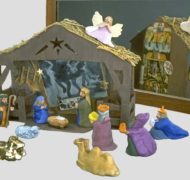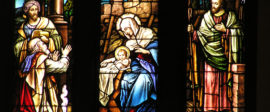Chlora’s Creche
Blog / Produced by The High Calling
(with adaptation of Emil Nolde's Dance around the Golden Calf, has 12 figurines)
2001 installed, app. 12" x 22" x 12" glazed porcelain with gold.
For more detail, visit www.gingergeyer.com.
Everything was under control
up on the mantle,
except for one Old Testament detail.
Chlora took the fatted calf out of
the sweet manger scene
and spray-painted it gold.
If reindeer and shepherds could nestle
together in the scratchy angel’s hair,
so could the Incarnation and the Second Commandment.
Now the rest of the crèche looked too humble,
so Chlora stuck a fancy Renaissance painting
on the back, hiding it from
that crazy Florentine monk
who threw paintings in bonfires.
Too bad he didn’t set sumptuary laws
where they are really needed, like in Dallas.
It was a mystical nativity with a nice cow,
some fallen angels
and no naked people,
the reverse of wild idolatry
in black and white.
Chlora guiltily worshiped the ads
for elaborate toy trains,
fearing Santa who was making a list
and checking it twice for naughty or nice,
unlike Baby Jesus, who checks for grace.
So instead she would ask for a modest magic kit,
and attempt to work wonders
with smoke and mirrors
just like those three magi.
Next year when they showed up to
fumigate that stinky nativity,
she’d rent a big fan,
recommend they bring toys instead,
and if they insisted otherwise,
she’d get Aaron to melt down their gold.
Copyright 2001 Ginger Henry Geyer
Chlora is a character who shows up in my work as an imaginary guide into my childhood and religious background. She looks like a cross between Pippi Longstocking and Anne Frank. When there’s a throbbing in my right ear, a playful disjoint sets in, and I know Chlora is on the line. My Grandmother Henry and my mother, with four little girls to keep in line, invented the Chlora stories on an as-needed basis. This little tyrant with the odd name got into whatever shenanigans we had just committed. The stories were moralistic and gripping. They began, “Chlora was a bad little girl.” Chlora became so realistic that she grew into a convenient scapegoat: It was Chlora, not me, who chopped up the National Geographics to make collages. She eventually moved on to art books and discovered that she liked tape and anything else that stuck. She was hard on toys. She fantasized about her future in the big city. She innocently garbled her religious training and bungled her friendships, but the nonsense created by Chlora remains openhearted and open-ended.
Chlora gets activated when there is too much “God-talk.” When things get obnoxiously earnest or tip into piosity, Chlora gets out the squeaky chalk. . . . She knows art is fun and is also hard work, and she rolls her eyes at glib declarations like, “All of us are artists!” Art jabberwocky, that pretentious aesthetic jargon—especially the self-serving kind, is just as odious to her. Chlora senses when the emperor is wearing no clothes, and like a goody two shoe, she politely says so.
Chlora questions my motives and makes me lighten up. She goes to the Episcopal Seminary with me and helps me confront my own bias. She takes Biblical images literally—that is, as they literally function in context—and then she messes with metaphors.
My most recent Chlora piece is Chlora’s Crèche. The crèche germinated in a previous piece (like much art), and then linked up with a bizarre Christmas Eve worship service at which our family had to go through a metal detector only seconds before receiving communion (that’s what you get when you end up at the same service as a President-elect). Ideas for the crèche began with Aaron, who took the heat for the golden calf. One idea fed the next: the calf made of gold and jewels lead to materialism, and that took me back to Dallas and to sumptuary laws and Girolamo Savonarola in Florence . . . and on to his influence on Botticelli, whose Mystical Nativity got painted on the crèche. Then I realized that the ox and ass are absent from the gospels but got lifted from Isaiah and now appear in every rococo crèche at Dillard’s. Chlora gets hold of a nativity set and spray-paints the cow gold. At least it wasn’t barbequed like the fatted calf.
Before I started this piece, I was rambling to a friend about my ideas. It was September, and I told her I was scouring Goodwills for a tacky cardboard crèche from the 1950s. I wanted a model from my own childhood, the classic type with straw or moss on the roof and brightly painted plaster figures. My friend looked stunned. “I have one in my car,” she said. Out in the parking lot she opened the trunk. The only thing in it was a 1950s nativity set, minus all the figures except a pink Baby Jesus in a scotch-taped manger. She had kept it in her trunk for months after cleaning out her mother’s home and didn’t have the heart to ditch it. This sign gave me the impetus to get started.
Sometimes a piece continues to unfold for me months after it is finished—a reminder that the call is ongoing. I knew the crèche was more than a jab at holiday consumerism, but I was surprised when it suggested to me later that the golden calf is an agent of grace: the little calf wears her gold uncomfortably; she is scalded by idolatry, yet she kneels humbly at the scene. Why would Christ call our idolatry to the manger rather than the cross? How does the incarnation transform the graven image? I’m uncertain, but the personal meaning was clear: Don’t confuse the call with the caller, or the gift with the giver. The second commandment jerked me back to the first commandment. The yearning to make meaningful art is not wrong, but it can override the yearning for God.
__________________________
Excerpt from Image: A Journal of the Arts & Religion, Number 33, Winter 2001, pp. 89-91











